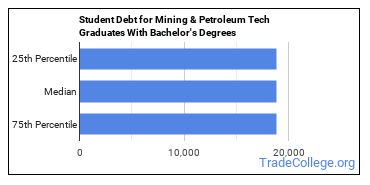Bachelor’s Degrees in Mining & Petroleum Technology
Featured schools near , edit
Education Levels of Mining & Petroleum Tech Majors
During the 2021-2022 academic year, 16 students earned their bachelor's degree in mining & petroleum tech. This makes it the 33rd most popular bachelor's degree program in the country.
The following table shows the number of diplomas awarded in mining & petroleum tech at each degree level.
| Education Level | Number of Grads |
|---|---|
| Associate Degree | 171 |
| Basic Certificate | 169 |
| Undergraduate Certificate | 54 |
| Bachelor’s Degree | 16 |
Earnings of Mining & Petroleum Tech Majors With Bachelor’s Degrees
The median salary for graduates holding a bachelor's degree in mining & petroleum tech is $59,846. A lot of factors can contribute to this number, such as the location of your workplace and the availability of other perks and bonuses. A better approximation of salary is to look at the typical range of salaries. In this case the low is $59,846 and the high is $59,846.

Student Debt
The median student debt for graduates holding a bachelor's degree in mining & petroleum tech is $17,417. The length of time it takes you to graduate and what college you attend can affect this number quite a bit. The chart below shows the range of accumulated debt loads. On the high side of the range, $17,417 is the debt load, and the debt load on the low side is $17,417.

Student Diversity
More men than women pursue bachelor's degrees in mining & petroleum tech. About 81.3% of graduates in this field are male.
| Gender | Number of Grads |
|---|---|
| Men | 13 |
| Women | 3 |

The racial-ethnic distribution of mining & petroleum tech bachelor’s degree students is as follows:
| Race/Ethnicity | Number of Grads |
|---|---|
| Asian | 0 |
| Black or African American | 4 |
| Hispanic or Latino | 0 |
| White | 11 |
| International Students | 1 |
| Other Races/Ethnicities | 0 |

Most Popular Mining & Petroleum Tech Programs for Bachelor’s Degrees
There are 2 colleges that offer a bachelor’s degree in mining & petroleum tech. Learn more about the most popular 2 below:
The most popular school in the United States for mining & petroleum tech students seekinga bachelor's degree is Nicholls State University. Roughly 6,200 attend the school each year. The average in-state tuition for full-time undergraduates is $4,922 per year, while in-state graduate students, on average, pay $5,686 per year. The mining & petroleum tech program at Nicholls State University awarded 25 bachelor's degrees during the 2021-2022 school year. Around 27% of these students were from an underrepresented racial-ethnic group, and 20% were women.
Muskingum University comes in at #2 on our list of the most popular colleges offering bachelor's degrees in mining & petroleum tech. The average in-state tuition for full-time undergraduates is $29,900 per year, while in-state graduate students, on average, pay $10,440 per year. For the 2021-2022 academic year, 0 bachelor's degrees were handed out to mining & petroleum tech majors at Muskingum.
Mining & Petroleum Tech Concentrations
| Major | Annual Degrees Awarded |
|---|---|
| Petroleum Technology | 16 |
Explore Major by State
Alabama
Arkansas
Connecticut
Florida
Idaho
Iowa
Louisiana
Massachusetts
Mississippi
Nebraska
New Jersey
North Carolina
Oklahoma
Rhode Island
Tennessee
Vermont
West Virginia
Related Majors
Below are some popular majors that are similar to mining & petroleum tech that offer bachelor’s degrees.
| Major | Annual Degrees Awarded |
|---|---|
| Electromechanical Engineering | 2,750 |
| Construction Engineering | 2,750 |
| Mechanical Engineering | 2,658 |
| Industrial Production Technology | 2,451 |
| Engineering-Related Fields | 1,858 |
References
*The racial-ethnic minority student count is calculated by taking the total number of students and subtracting white students, international students, and students whose race/ethnicity was unknown. This number is then divided by the total number of students at the school to obtain the percentage of racial-ethnic minorities.
- College Factual
- National Center for Education Statistics
- O*NET Online
- Bureau of Labor Statistics
- Image Credit: By Jeffrey Beall under License
More about our data sources and methodologies.
Featured Schools
 Request Info
Request Info
|
Southern New Hampshire University You have goals. Southern New Hampshire University can help you get there. Whether you need a bachelor's degree to get into a career or want a master's degree to move up in your current career, SNHU has an online program for you. Find your degree from over 200 online programs. Learn More > |


